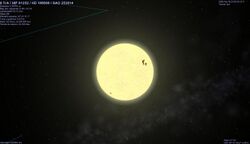Astronomy:Theta Trianguli Australis
| Observation data Equinox J2000.0]] (ICRS) | |
|---|---|
| Constellation | Triangulum Australe |
| Right ascension | 16h 35m 44.81924s[1] |
| Declination | −65° 29′ 43.4478″[1] |
| Apparent magnitude (V) | +5.50[2] |
| Characteristics | |
| Spectral type | G8-K0 III[3] |
| U−B color index | +0.73[2] |
| B−V color index | +0.93[2] |
| Astrometry | |
| Radial velocity (Rv) | 9.6±2.8[4] km/s |
| Proper motion (μ) | RA: +35.117[1] mas/yr Dec.: −29.356[1] mas/yr |
| Parallax (π) | 9.7682 ± 0.0849[1] mas |
| Distance | 334 ± 3 ly (102.4 ± 0.9 pc) |
| Absolute magnitude (MV) | +0.40[5] |
| Details | |
| Radius | 11[6] R☉ |
| Luminosity | 79[7] L☉ |
| Surface gravity (log g) | 2.81±0.08[8] cgs |
| Temperature | 5,039±31[8] K |
| Metallicity [Fe/H] | −0.05±0.03[8] dex |
| Other designations | |
| Database references | |
| SIMBAD | data |
θ Trianguli Australis, Latinized as Theta Trianguli Australis, is a single[10] star in the southern constellation of Triangulum Australe. It is visible to the naked eye as a dim, yellow-hued star with an apparent visual magnitude of +5.50.[2] The star is located about 334 light years from the Sun based on parallax, and is drifting further away with a radial velocity of +10 km/s.[4]
This is an evolved G/K-type giant star with a stellar classification of G8-K0 III.[3] The interferometry-measured angular diameter of the primary component is 0.99±0.01 mas,[11] which, at its estimated distance, equates to a physical radius of about 11 times the radius of the Sun.[6] The star is radiating 79[7] times the Sun's luminosity from its photosphere at an effective temperature of 5,039 K.[8]
References
- ↑ Jump up to: 1.0 1.1 1.2 1.3 1.4 Brown, A. G. A. (August 2018). "Gaia Data Release 2: Summary of the contents and survey properties". Astronomy & Astrophysics 616: A1. doi:10.1051/0004-6361/201833051. Bibcode: 2018A&A...616A...1G. Gaia DR2 record for this source at VizieR.
- ↑ Jump up to: 2.0 2.1 2.2 2.3 Johnson, H. L. et al. (1966), "UBVRIJKL photometry of the bright stars", Communications of the Lunar and Planetary Laboratory 4 (99): 99, Bibcode: 1966CoLPL...4...99J.
- ↑ Jump up to: 3.0 3.1 Houk, N.; Cowley, A. P. (1975), University of Michigan Catalogue of two-dimensional spectral types for the HD stars, 1, Ann Arbor, MI: Department of Astronomy, University of Michigan, pp. 452, Bibcode: 1975mcts.book.....H.
- ↑ Jump up to: 4.0 4.1 de Bruijne, J. H. J.; Eilers, A.-C. (October 2012), "Radial velocities for the HIPPARCOS-Gaia Hundred-Thousand-Proper-Motion project", Astronomy & Astrophysics 546: 14, doi:10.1051/0004-6361/201219219, A61, Bibcode: 2012A&A...546A..61D.
- ↑ Anderson, E.; Francis, Ch. (2012), "XHIP: An extended hipparcos compilation", Astronomy Letters 38 (5): 331, doi:10.1134/S1063773712050015, Bibcode: 2012AstL...38..331A.
- ↑ Jump up to: 6.0 6.1 Lang, Kenneth R. (2006), Astrophysical formulae, Astronomy and astrophysics library, 1 (3rd ed.), Birkhäuser, ISBN 3-540-29692-1, https://books.google.com/books?id=OvTjLcQ4MCQC&pg=PA41. The radius (R*) is given by:
- [math]\displaystyle{ \begin{align} 2\cdot R_* & = \frac{(10^{-3}\cdot 102.4\cdot 0.99)\ \text{AU}}{0.0046491\ \text{AU}/R_{\bigodot}} \\ & \approx 21.8\cdot R_{\bigodot} \end{align} }[/math]
- ↑ Jump up to: 7.0 7.1 McDonald, I. et al. (2012), "Fundamental Parameters and Infrared Excesses of Hipparcos Stars", Monthly Notices of the Royal Astronomical Society 427 (1): 343–57, doi:10.1111/j.1365-2966.2012.21873.x, Bibcode: 2012MNRAS.427..343M.
- ↑ Jump up to: 8.0 8.1 8.2 8.3 Alves, S. et al. (April 2015), "Determination of the spectroscopic stellar parameters for 257 field giant stars", Monthly Notices of the Royal Astronomical Society 448 (3): 2749–2765, doi:10.1093/mnras/stv189, Bibcode: 2015MNRAS.448.2749A.
- ↑ "tet TrA". SIMBAD. Centre de données astronomiques de Strasbourg. http://simbad.u-strasbg.fr/simbad/sim-basic?Ident=tet+TrA.
- ↑ Eggleton, P. P.; Tokovinin, A. A. (September 2008), "A catalogue of multiplicity among bright stellar systems", Monthly Notices of the Royal Astronomical Society 389 (2): 869–879, doi:10.1111/j.1365-2966.2008.13596.x, Bibcode: 2008MNRAS.389..869E.
- ↑ Richichi, A. et al. (February 2005), "CHARM2: An updated Catalog of High Angular Resolution Measurements", Astronomy and Astrophysics 431 (2): 773–777, doi:10.1051/0004-6361:20042039, Bibcode: 2005A&A...431..773R.
 |


